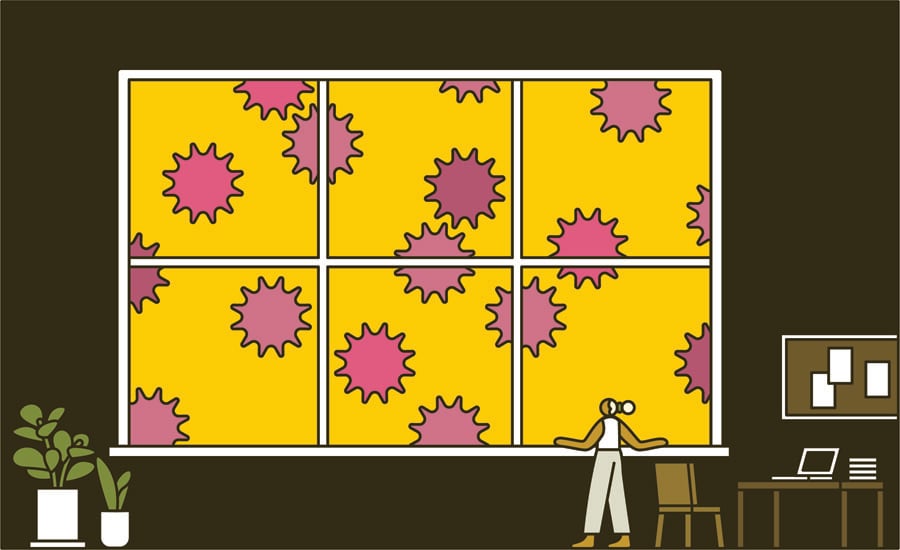
June 8, 2020
Emerging from a Public Health Crisis, Companies Get Set to Invest in Hygienic Office Design
Private enterprises are rediscovering that the workforce has a life outside the office—and that brings risks they were not prepared for.

For many office-goers at the moment, work is happening at home and online. But eventually, we will agree on guidelines, establish protocols, and find a vaccine for the novel coronavirus. Then the office will make a comeback, as will the coworking space and the café. We will also find that work can happen anywhere and be supported in any way we want—if we make the right decisions now. In our June issue, Metropolis tracked five concepts—loneliness, public health, neurodiversity, remote work, and experience management—that anyone involved in the design of workplaces needs to start taking seriously. Paying attention to them won’t take us back to business as usual. It will inspire us to do it better than it was done before.
___
In April, about a month after China eased the lockdown in Wuhan, Francois Chimier, a senior designer in Gensler’s Beijing outpost, published a firsthand account of going back to the office on the firm’s blog. Some of his experiences are likely to become routine around the world. “Each day the space is disinfected, and we must disinfect our working surface and chair daily too,” he wrote. “Meeting rooms can only be occupied to half of their capacity.”
Other measures seem specific to China—at least for now. For example, in more than 200 Chinese cities, anyone seeking to enter certain workplaces must scan in an app-based QR code called Alipay Health Code, which grants or denies access based on the user’s previous location data. To obtain a code, users must consent to share their data with the program, which The New York Times reported includes an undisclosed piece called “reportInfoAndLocationToPolice.”
This wide range of approaches—from handing out Lysol wipes to requiring surveillance by law enforcement—highlights a fundamental lacuna in how workplaces have thus far addressed the issue of health and safety. The “hierarchy of controls,” a CDC-recommended framework used by organizations around the world to protect themselves against health risks, ranks strategies like enforcing hand-washing as pretty low in effectiveness. Meanwhile, the framework’s top recommendation—elimination of the threat—seems impossible for any organization to achieve.
The problem lies in ignoring the reality that employees are embedded in lives and communities beyond the office, which employers cannot influence. In 2018, the nonprofit Integrated Benefits Institute estimated that U.S. employers paid nearly $880 billion in health-care benefits for employees and their dependents, with lost productivity due to illness costing those companies an additional $530 billion a year. When a pandemic increases the risk that employees and their families could be infected by neighbors and strangers, the system is bound to be overextended. That’s when private enterprise comes face-to-face with public health, and dystopia lurks around the corner.
There is, however, another front where corporations have begun to think holistically about both their responsibilities and their bottom lines: sustainability. In recent years, the design-driven healthy buildings movement has grown as an offshoot of the fight against climate change. “What we stumbled on in the green building movement,” says architect Rick Cook, founding partner of COOKFOX Architects, “was that when we make buildings better for the planet, we could make them quantifiably better for people.”
The key word is “quantifiable.” In addition to OSHA regulations and CDC guidelines, corporations can now adopt a range of wellness strategies codified within certifications such as LEED v4, the WELL Building Standard, Fitwel, and the Living Building Challenge. In the wake of COVID-19, the organizations behind these standards are looking into the next generation of measures for healthy spaces. “We’re coming to realize that as designers, architects, and building managers, we have a critical role to play in public health,” says Rachel Gutter, president of the International Well Building Institute (IWBI), which created the WELL standard. (Disclosure: Earlier this year, I began serving on the IWBI’s governance council.)
The IWBI’s Task Force on COVID-19 and Other Respiratory Illnesses is gather-ing input from 500 experts around the world and intends to release new guidelines in August. For its part, the U.S. Green Building Council, which oversees the LEED certification, has also announced a reimagined vision: “Healthy people in healthy places equals a healthy economy.” A whole host of measures will follow, including a broad call for ideas about how the sustainability movement can address public health challenges.
These moves are part of a widespread recognition that organizations must include public health in their resilience plans, alongside their preparation for other shocks such as natural disasters. Like insurers, which are developing products to help companies weather public health crises, architects and designers must start building solutions that go beyond the CDC’s “hierarchy of controls.” There are better ways to keep people healthy and safe than forcing them to relinquish personal data—they just haven’t been designed yet.
You may also enjoy “5 Ways Architects and Designers are Responding to COVID-19.”
Would you like to comment on this article? Send your thoughts to: [email protected]
Register here for Metropolis Webinars
Connect with experts and design leaders on the most important conversations of the day.
Recent Viewpoints
Viewpoints
Sustainability News Updates for Q2 2025





